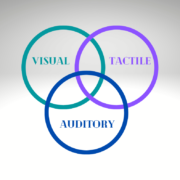What is Your Learning Style?
Did you know that there are different ways of learning?
There are 3 main learning styles. Everyone is going to learn slightly differently. Knowing how you or your child learns best gives you the tools to help you to succeed.
The 3 main learning styles are:
Auditory: Learning by hearing and listening.
Visual: Learning by reading or seeing pictures.
Tactile: Learning by touching and doing.
All individuals will be a combination of each of these. You will have some ways of learning that will be easier for you and some that will be more challenging. An example would be an individual who is 65% tactile, 25% visual, and 10% auditory. So to support their most appropriate mode of learning, they should be encouraged to move and be physically involved in the learning. The auditory score being so low means that it is a struggle for this individual to learn just from someone talking or listening to something. They may have to work a lot harder to learn using only an auditory-style of learning. However if they were able to include tactile or visual aspects, this may allow for easier learning.
If this individual were listening to a lecture, and taking notes, they may struggle to retain a lot of the information being given. However, if they color code or draw pictures in their notes that may help them to better understand and remember what is being said. Then they can review the notes later and will have the visual clues in the colors and pictures added into the notes.
Do you know how you/your children learn best?
Would you like to? Click HERE to answer a 20 question Questionnaire, where there are no right or wrong answers. The website will break down what percent out of 100 you are with each of the three styles of learning.
After you finish the questionnaire the website will explain each one in more detail as well as give examples of ways to learn more efficiently. Below are a few examples of ways to utilize your preferred learning style to your benefit, by Dr. Michael W. Kirst of Stanford University.
Visual– Draw pictures and diagrams in the margins while reading and write out questions you are working on. Underling and highlight text as you read and make flashcards for studying (use different colored cards). Copy over your notes to help with recall. Preview a chapter before reading it by first looking at the pictures and section headings.
Auditory – Listen to the words you read and read aloud or talk through the information. Record lectures, tutoring and study group sessions, etc. Make up and repeat rhymes to remember facts, dates, and names. Study in groups and particulate in class discussions and debates. Have a friend or classmate quiz you on vocabulary words and recite the word and definition out loud frequently. After you read a section, summarize it out loud.
Tactile/Kinesthetic – Walk around as you read and listen to recordings of lectures and notes. Engage your fingers while studying by tracing words and re-writing sentences to learn key facts. If you have a stationary bicycle, try reading while pedaling and studying with music in the background. Try squeezing a Nerf ball or bouncing a foot on the floor.
Just because you know your learning style does not automatically mean you will be able utilize it to its fullest potential. In our office we see people with a wide range of visual difficulties. Quite a few of our patients could be primarily visual learners due to the way their brain is wired. However if the eyes are not working quite right it can greatly impact the ability to learn at the highest potential.



